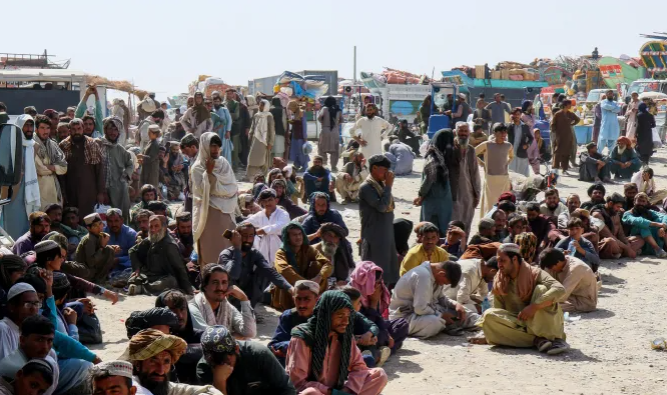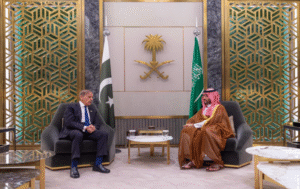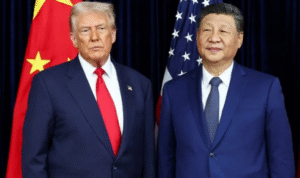The Take: Pakistan and the Taliban’s Uneasy Peace

Meta Description:
After years of cooperation and shared history, Pakistan and Afghanistan’s Taliban government now find themselves at odds. Border clashes, trade suspensions, and security mistrust are testing one of South Asia’s most complex relationships.
Introduction
For decades, Pakistan and Afghanistan’s Taliban movement were seen as uneasy allies bound by geography, religion, and shared strategic interests. But today, the relationship stands at a crossroads.
Recent border clashes, trade suspensions, and diplomatic strains have exposed widening cracks in a partnership once described as “brothers in faith.” The images from Chaman and Torkham — Afghan families stranded, trucks piled high with belongings, and traders caught in limbo — reveal the high human and economic cost of this growing rift.
After years of acting as a facilitator for the Taliban, Pakistan now faces an unintended consequence: a neighbor it helped bring to power but cannot easily control.
A Fragile Relationship Reaches Breaking Point
From Cooperation to Confrontation
The uneasy peace between Pakistan and the Taliban has been deteriorating for months. The trigger was a series of cross-border attacks in which Pakistani officials blamed militants using Afghan territory as a launchpad for assaults on Pakistani security forces.
In response, Pakistan conducted airstrikes inside Afghanistan, targeting alleged hideouts of the Tehrik-e-Taliban Pakistan (TTP) — a banned militant group that has pledged allegiance to the Afghan Taliban but operates against Islamabad.
Afghanistan’s Taliban government, led by Mullah Mohammad Hassan Akhund, condemned the strikes as a violation of sovereignty. The retaliatory gunfire, border closures, and diplomatic tensions that followed pushed both nations to the brink of open confrontation.
The Doha Ceasefire
Amid the escalating hostility, Qatar and Turkiye stepped in as mediators. After a week of negotiations in Doha, both countries announced an “immediate ceasefire” and a phased reopening of trade routes.
Pakistan agreed to resume Afghan transit trade, while the Taliban promised to curb cross-border militant activity. The ceasefire brought temporary calm — but underlying tensions remain unresolved.
The Historical Backdrop: Brothers Turned Rivals
Pakistan’s Role in the Taliban’s Rise
To understand the current strain, it’s essential to revisit the origins of Pakistan’s relationship with the Taliban.
In the 1990s, Pakistan’s intelligence agency, the Inter-Services Intelligence (ISI), played a pivotal role in supporting the Taliban’s rise to power. The movement, composed largely of Pashtun students and clerics, emerged from religious seminaries along the Pakistan-Afghanistan border.
Islamabad viewed the Taliban as a stabilizing force that could secure its western border and offer “strategic depth” against India. When the Taliban seized Kabul in 1996, Pakistan was among the few countries to officially recognize their rule.
The Post-9/11 Reversal
Everything changed after the September 11 attacks. Under US pressure, Pakistan joined Washington’s “War on Terror,” turning against the same Taliban leadership it once supported.
The Taliban leadership, driven from Afghanistan, found refuge in parts of Pakistan — particularly in Quetta and Khyber Pakhtunkhwa. This dual relationship — fighting terrorism while sheltering militants — became one of Pakistan’s most controversial foreign policy dilemmas.
The TTP Factor: A Shadow War
Pakistan’s Persistent Security Nightmare
The Tehrik-e-Taliban Pakistan (TTP), also known as the Pakistani Taliban, has become the biggest spoiler in the Islamabad-Kabul relationship.
Although the Afghan Taliban deny sheltering the TTP, Pakistani officials argue that the group enjoys safe havens inside Afghanistan. The TTP has carried out hundreds of attacks on Pakistani soil, targeting military convoys, police posts, and schools.
In 2023 alone, Pakistan recorded a 60 percent rise in terrorist incidents, many traced back to the border regions of Kunar and Nangarhar provinces.
The Taliban’s Dilemma
For Kabul, confronting the TTP is politically complicated. Both groups share ideological and tribal roots. Ordering a crackdown on fellow jihadists could alienate Taliban factions, risking internal dissent.
Thus, the Taliban government walks a tightrope: promising cooperation with Pakistan while quietly tolerating the TTP’s presence — a stance Islamabad sees as duplicity.
The Economic Fallout: Borders Closed, Livelihoods Lost
Trade as a Casualty of Politics
When Pakistan closed its border crossings in early October, trade between the two countries ground to a halt. The closure stranded thousands of trucks carrying goods such as cement, fruit, and textiles.
The Chaman crossing, one of the busiest in South Asia, was sealed for ten days, leaving hundreds of Afghan families stranded. These border towns depend heavily on daily cross-border movement for their livelihoods.
After the Doha ceasefire, Pakistan announced a phased reopening of the Afghan Transit Trade, beginning with 300 stranded vehicles. But the disruption caused lasting economic damage — to traders, truck drivers, and local communities alike.
Afghan Refugees Caught in the Crossfire
Compounding the humanitarian fallout is Pakistan’s recent crackdown on undocumented Afghan refugees. Islamabad has ordered tens of thousands to return home, citing security concerns and economic pressures.
At the Chaman and Torkham crossings, long queues of families wait beside trucks piled high with household goods. For many, this is not the first time they’ve fled — and few believe it will be the last.
The Regional Power Game
Pakistan’s Strategic Balancing Act
Pakistan’s geopolitical calculus has always been complex. It must juggle relations with Afghanistan, China, Iran, and the United States, while confronting internal militancy and economic challenges.
Islamabad sees a stable Afghanistan as vital to its China-Pakistan Economic Corridor (CPEC) and regional trade ambitions. Yet, an emboldened Taliban unwilling to curb militancy could threaten that very vision.
Afghanistan’s Search for Legitimacy
For the Taliban, international recognition remains elusive. The regime seeks diplomatic legitimacy, trade access, and humanitarian aid — all of which are easier to secure if relations with Pakistan remain functional.
But the Taliban’s nationalist rhetoric and assertive border policies show a movement increasingly unwilling to act as Pakistan’s junior partner. Kabul’s leaders have accused Islamabad of treating Afghanistan as a vassal state, while Pakistan counters that the Taliban’s inaction on terrorism undermines bilateral trust.
Voices from the Border
On both sides of the Durand Line, the 2,640-kilometre border that divides Pashtun tribes, civilians pay the price for political miscalculation.
Ahmed Khan, a trader from Chaman, described the uncertainty:
“Every few months, the border closes. Our goods spoil, our trucks sit idle, and our families suffer. Both governments talk about brotherhood, but we only see barriers.”
In Spin Boldak, Afghanistan, residents express similar frustration.
“Pakistan helped the Taliban when no one else would,” said shopkeeper Mohammad Yousuf. “Now both sides act like enemies. It’s ordinary people who lose.”
The Diplomatic Challenge Ahead
Dialogue or Deadlock?
The Doha talks prevented further bloodshed, but experts say they were a temporary fix, not a solution.
Diplomats from Qatar and Turkey have encouraged both nations to establish a joint border commission, aimed at reducing misunderstandings and improving trade coordination.
However, unless Islamabad and Kabul can agree on a mechanism to address cross-border militancy, future clashes seem inevitable.
The Trust Deficit
As analyst Zahid Hussain notes:
“Pakistan expected the Taliban to be a partner against terrorism. Instead, it’s facing a government that shares ideology with the very militants it fights.”
This mistrust is compounded by mixed messaging: Pakistan publicly supports Afghanistan’s reconstruction while simultaneously conducting airstrikes across the border.
For Kabul, such contradictions prove Pakistan’s unreliability; for Islamabad, they underscore the Taliban’s duplicity.
The Broader Implications for South Asia
The Pakistan-Taliban standoff has regional ripple effects.
- China worries that instability could threaten CPEC investments and trade routes connecting Central Asia.
- Iran, already critical of Pakistan’s refugee policy, has urged restraint.
- India quietly watches the unfolding chaos, seeing Pakistan’s discomfort as strategic leverage.
Meanwhile, international aid agencies warn that renewed border conflict could exacerbate Afghanistan’s humanitarian crisis, where more than half the population already faces food insecurity.
A Relationship Defined by Mutual Suspicion
The phrase “uneasy peace” perfectly captures the state of affairs between Islamabad and Kabul. Neither side wants war — yet neither trusts the other enough to secure lasting peace.
Pakistan’s security establishment remains wary of Taliban nationalism morphing into anti-Pakistan sentiment, while the Taliban view Pakistan’s border policies as heavy-handed interference.
“It’s a relationship built on fear and necessity, not mutual respect,” said a South Asian diplomatic observer in Islamabad. “Each side sees the other as both ally and adversary.”
Conclusion: Between Peace and Peril
Pakistan and the Taliban’s uneasy peace is a mirror of history repeating itself — a cycle of cooperation, confrontation, and reluctant coexistence.
While the Doha ceasefire has brought temporary calm, true stability will depend on mutual recognition of each other’s sovereignty and limitations. Pakistan must balance its security concerns with humanitarian realities, and Afghanistan must address militant sanctuaries within its borders.
If mistrust continues to dominate policy, the region risks sliding into another era of proxy conflict and economic paralysis. But if dialogue prevails, the two neighbours could turn a volatile frontier into a corridor of opportunity.
For now, however, peace remains as fragile as the border fence itself.






